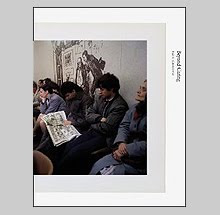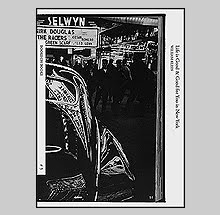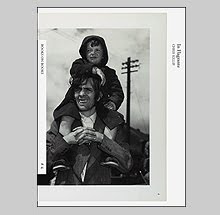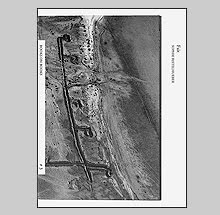Catalogs On the Work of Robert Frank

The work of Robert Frank has been the subject of many books and exhibitions. Many words have been spent on his actual books, so I thought I would take a look at some of the small catalogs that have been published over the years.
From March 29th to May 10th of 1985, the Alfons el Magnanim Institute of Studies and Investigation in Valencia, Spain held an exhibition of the work of Robert Frank in their Parpallo gallery. In addition to exhibiting the work, the Institute published two wonderful catalogs and a brochure to accompany the exhibition.
The more common of the three is the catalog called Robert Frank: Fotografias/Films 1948/1984. This book covers Frank’s career much in the way that any catalog might and it includes about 11 images that Frank aficionados may not recognize. At 175 pages it is substantial; the reproductions are good but not great.
This catalog contains several essays in Spanish. The first is by Jno Cook who in 1983 released his own translation of The Americans as a coloring book. The Robert Frank Coloring Book is comprised of line drawings of each of the 83 photographs that appear in The Americans. 
Other essays are by Vincent Todoli and Martin Schaub. There is also a letter to Robert Frank from Gotthard Schuh who was one of Frank’s teachers. All of the texts are in Spanish.
The second object from the Valencia exhibition is a 12 page pamphlet called Por La Carretera Hacia Florida (On the Road to Florida). It is about the trip that Robert Frank and Jack Kerouak took in 1958 to pick up Kerouac’s mother in Florida and move her to Northport, Long Island. The story, written by Kerouac, was published in the Evergreen Review in January of 1970. That text can be found on page 38 of Robert Frank: New York to Nova Scotia.
One curious little note is that the diner that Frank and Kerouac “stopped in for a snack” may have been (I reiterate, may have been) a place that was called Earl’s in New Castle, Delaware. That actual diner was later moved to Sommerville Massachusetts and is still in business as Kelly’s Diner.
In 1940, John Vachon while photographing for the Farm Security Administration also stopped by to make some photographs of Earl’s Diner. Unfortunately he was photographing at night so the actual building is under lit. He managed to photograph the interiors of other diners further down highway 40 but not inside of Earl’s.
(LOC Call # LC-USW3-018222-D)
OK…back to the catalogs.
The most interesting of these three Valencia publications for me is a small catalog called Robert Frank: Sobre Valencia 1950 (On Valencia 1950). This is a catalog of only 24 photographs and two contact sheets but to my knowledge, none of the images have appeared in any of his previous books. The work is accompanied by his “Black and White Are the Colors of Photography” statement.
Black and white are the colors of photography. To me they symbolize the alternatives of hope and despair to which mankind is forever subjected. Most of my photographs are of people; they are seen simply, as through the eyes of the man in the street. There is one thing the photograph must contain, the humanity of the moment. This kind of photography is realism. But realism is not enough--there has to be vision, and the two together can make a good photograph. It is difficult to describe this thin line where matter ends and mind begins. -Robert Frank
The work in this catalog is divided into two sections. The first is photographs of daily life in Valencia and then after a center spread of a couple reproductions of contact sheets, we are treated to small photo essay on young bullfighters in training. The last photograph is of a young fighter seemingly about to enter the ring for the first time.
This is a wonderful small catalog but I fear that it is very difficult to find.
For those of you who are interested in connecting the dots of the work of Robert Frank, Stuart Alexander’s obsessively detailed Robert Frank: A Bibliography, Filmography and Exhibition Chronology 1946-1985, is the source book that will become dog-eared in no time. This title is still available through the Center for Creative Photography and is $25.00. (www.creativephotography.org)
As crazy as it may sound, this book is actually a fascinating read in that it is probably one of the most complete sources of a working life one could provide just short of a diary. I think Frank’s career is generally thought about in the post-publication of The Americans era but this book details all of the freelance photo jobs he took in those early years.
Warning: There are no photographs reproduced in this book, it is strictly for the scholar or a sufferer of Asperger’s Syndrome who has Robert Frank in their sights.
One fairly common catalog is from the Akron Art Museum entitled Robert Frank and American Politics. This book includes work by Frank from 1955-56 and 1984. In 1984 Frank was assigned by California magazine to photograph the San Francisco Democratic National Convention by Harold Hayes who was a former editor at Esquire. 28 Years before, Hayes had worked on a layout for Esquire of Frank’s Chicago Democratic Convention photographs but after seeing the critique the images cast on their subjects, Esquire killed the essay.
“Robert’s photographs were strong. It was a powerful layout. Esquire tried in those days to stay away from one side or the other of politics. This layout, when we looked at it, was so strongly cast against the subjects, we never ran it. It was one of the greatest omissions of my time at Esquire.” - Harold Hayes
In September of 1984, fifteen of Frank’s photos from the convention ran in California magazine.
In 1979 the Sidney Janis Gallery exhibited 112 photographs in a show called The Americans and New York Photographs. This thin booklet contains 12 images and about 9 are rarely seen. It is nice but I am sure that book dealers charge a bundle for this as Sidney Janis was an important figure and his catalogs were popular. So at the current prices, it probably isn’t worth the effort of tracking down a copy.
The next catalog is from a show that was in Lisbon, Portugal in 1988 simply called Robert Frank. It reproduces 19 photographs and Polaroid works that span Frank’s career.
A letter from Frank in the beginning of the catalog states:
Dear Albano
33 fotos – Pepe is OK – The weather too.
I don’t know why I do this exhibit
maybe you sound OK on the phone
maybe it will be good.
Please call when you get the photos
it’s a selection of what I had left
here in the house – please treat them
carefully as I don’t print anymore –
It’s the past – and it continues…
Salud R.
I like the tone of this letter as it seems to convey the demand on him and his reluctance to exhibit the work. “It’s the past – and it continues…”
This catalog isn’t much to write home about besides that it reproduces three images that are fairly uncommon; a girl in Paris looking up at a Charles Chaplin mask, a group of Parisian gypsy children standing on the running board of an old automobile, (both are reproduced in the DU Part II magazine) and a portrait of a black man at Coney Island holding dolls which could be prizes from an arcade. If you get to see this last image in a respectable reproduction, the description of the man’s shirt is amazing.
The last catalog from 2003 is from an international symposium called National Literature Today – A Phantom? The Swiss Imagination and Tradition as Problem, which was held in Zurich, Switzerland. This was a symposium of writers, poets who were debating whether a noticeable Swiss ethos exists in literature and art. I’m not sure what the outcome was, but during the debate and between coffee breaks, they had an exhibition of 24 Robert Frank photographs.
Out of the 24 images featured here, I had not seen 19 of them before. This is a nice small format booklet that reproduces all of the images the same size and oriented vertically on the page to follow the format of the booklet. Therefore, to properly view the horizontals, you have to turn the booklet sideways.
Frank abandons the captions to the photos and says to “just look at the photographs.”
Because of this, it seems that perhaps he edited and sequenced these images for the exhibition and booklet unlike many other catalogs that are done without the artist’s attention. There does seem to be a metaphor being presented to us as there are lots of photos that include people looking at spectacles, children and many that include barriers of sorts.
The preoccupation of the symposium begs the question…Is there something identifiably Swiss about Robert’s photographs?
Book Available Here (Me and My Brother)
Book Available Here (Moving Out)
Book Available Here (Hold Still Keep Going)











